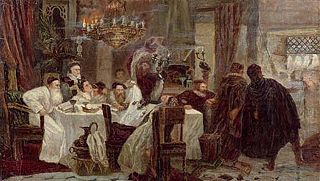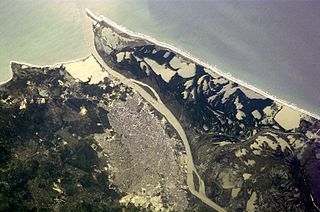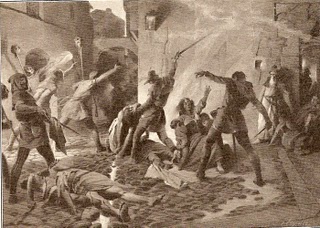| Total population | |
|---|---|
| 14,700 | |
| Regions with significant populations | |
| Bogotá | |
| Languages | |
| Spanish, Hebrew, Yiddish, Ladino | |
| Religion | |
| Judaism and Christianity |
| Part of a series on |
| Jews and Judaism |
|---|
The History of the Jews in Colombia begins in the Spanish colonial period with the arrival of the first Jews during the Spanish colonization of the Americas.
"New Christians", or Marranos, fled the Iberian peninsula to escape persecution and seek religious freedom during the 16th and 17th centuries. It is estimated that some reached northern areas of Colombia, which at the time was known as New Granada. Most if not all of these people assimilated into Colombian society. Some continue to practice Jewish rituals as family traditions.
In the 18th century, practicing Spanish and Portuguese Jews came from Jamaica and Curaçao, where they had flourished under English and Dutch rule. These Jews started practicing their religion openly in Colombia at the end of the 18th century, although it was not officially legal to do so, given the established Catholic Church. After independence, Judaism was recognized as a legal religion. The government granted the Jews land for a cemetery.
Many Jews who came during the 18th and 19th centuries achieved prominent positions in Colombian society. Some married local women and felt they had to abandon or diminish their Jewish identity. These included author Jorge Isaacs of English Jewish ancestry, the industrialist James Martin Eder (who adopted the more Christian name of Santiago Eder when he translated his name to Spanish) born into the Latvian Jewish community, as well as the De Lima, Salazar, Espinoza, Arias, Ramirez, Nunez, Lindo, Tafur, Lozano, Lerma, Vinasco, De Castro, Perez and Lobo families of Antillean Sephardim. Coincidentally, these persons and their families settled in the Cauca Valley region of Colombia. They have continued to be influential members of society in cities such as Cali, Palmira and Tulua. Over the generations most of their descendants were raised as secular Christians.
During the early part of the 20th century, numerous Sephardic Jewish immigrants came from Greece, Turkey, North Africa and Syria. Shortly after, Jewish immigrants began to arrive from Eastern Europe. A wave of Ashkenazi immigrants came after the rise of Nazism in 1933 and the imposition of anti-Semitic laws and practices, followed by as many as 17,000 German Jews. From 1939 until the end of World War II, immigration was put to a halt by anti-immigrant feelings in the country and restrictions on immigration from Germany. [1]
Colombia asked Germans who were on the U.S. blacklist to leave and allowed Jewish refugees in the country illegally to stay. [2] President Laureano Gómez actively supported and helped the Jewish Community through this troubling time.[ citation needed ] The Jewish population increased dramatically in the 1950s and 1960s, and institutions such as synagogues, schools and social clubs were established throughout the largest cities in the country. [3] Rabbi Eliezer Roitblatt was the first rabbi to arrive in Colombia in 1946, and served as its first Ashkenazi Chief Rabbi. [4] In the 1950s, a Sephardic Jewish community originating in particular from Syria, Turkey and Egypt was created with Rabbi David Sharbani serving as the Sephardic Chief Rabbi. [5]
A wave of kidnappings during the last decade of the 20th century led some members of Colombia's Jewish community to emigrate. Most settled in Miami and other parts of the United States. Successes in the nation's democratic security policy has encouraged citizens to return; it has drastically reduced violence in the rural areas and criminality rates in urban areas, as well as in spurring the economy.[ citation needed ] The situation in Colombia has improved to the extent that many Venezuelan Jews are now seeking refuge in Colombia.[ citation needed ]
In the department of Antioquia, as well as in the greater Paisa region, some families hold traditions and oral accounts of Jewish descent. In this population, Y-DNA genetic analysis has shown an origin of male founders predominantly from "southern Spain but also suggest that a fraction came from northern Iberia and that some possibly had a Sephardic origin". [6] Medellín has a tradition of the marranada, where a pig is slaughtered, butchered and consumed on the streets of every neighborhood each Christmas. This custom has been interpreted as an annual affirmation of the rejection of Jewish law. [7]
It was known that some Spanish and Portuguese New Christians of Sephardic Jewish ancestry fled the Cartagena de Indias Inquisition and took refuge in the Antioquian mountains during the sixteenth and seventeenth century. Some Colombian authors like Jorge Isaacs and Miguel Ángel Osorio have claimed that it is indisputable that Paisas have Jewish ancestry. Several Paisa surnames are known to have been prevalent among New Christian conversos of Sephardic Jewish origin, for example Espinosa, Pérez, Mejía, and many others.[ citation needed ]
Some scholars state that the presence of Sephardic Jews among the ancestors of Paisas is a fact, but it does not mean that all Paisas descend from them, nor that it is the only or predominant element among those that do, as is proven by the Paisas' descent from other groups like Basques, Extremadurans, and Andalusians. [8]
The history of the conversos in the New Granada, now known as Colombia, is a rich and complex narrative that spans across various regions of the country. These individuals, originally seeking refuge from the Spanish Inquisition, established themselves not only in the Paisa region but throughout the entire territory of the New Granada. [9]
They settled in various regions, including the Paisa area (Antioquia) known for its mountainous terrain and relative isolation. This isolation provided a haven for many conversos who were fleeing persecution. However, the Sephardic diaspora extended well beyond the Paisa region. Significant populations of conversos were found in the central parts of the kingdom, particularly in the regions of Boyacá, Santander, and Cundinamarca. Despite their conversion to Christianity, conversos in the New Granada were not free from the reach of the Inquisition. The Inquisition pursued suspected heretics and crypto-Jews throughout the country. Many conversos were tried and persecuted, facing charges of relapsing into Judaism. The center of the kingdom, including Boyacá, Santander, and Cundinamarca, was particularly noted for the presence of these individuals, and many records of the Inquisition trials come from these areas. [10]
The influence of Sephardic Jews in Colombia is significant. It has been established that a considerable proportion of the Colombian population has Sephardic ancestry. In particular, studies have shown that a notable percentage of Antioqueños are descended from Sephardic Jews. However, this heritage is not confined to Antioquia alone. It is estimated that around 10% of the Colombian population carries Jewish DNA, specially in the Andes regions, indicating a widespread Sephardic influence throughout the country.
As of the 21st century, approximately 14,700 Jews live in Colombia. Most of them are concentrated in Bogotá, with about 6,000 members, and Cali, with about 3,500 members. New communities have sprung up in Barranquilla and Medellín. Very few Jews practice religious observance; among those who do, the majority are Orthodox. German Jewish communities in Bogota and Cali also preserve much of their traditions. [11]
Smaller communities are found in Cartagena and the island of San Andres. There are approximately 10 official synagogues throughout the country. In Bogotá, the Ashkenazi, Sephardic, and German Jews each run their own religious and cultural institutions. The Confederación de Asociaciones Judías de Colombia, located in Bogotá, is the central organization that coordinates Jews and Jewish institutions in Colombia.
In the new millennium, after years of study, a group of Colombians with Jewish ancestry formally converted to Judaism in order to be accepted as Jews according to the rabbinical interpretation of the halakha. [12]

SephardicJews, also known as Sephardi Jews or Sephardim, and rarely as Iberian Peninsular Jews, are a Jewish diaspora population associated with the Iberian Peninsula. The term, which is derived from the Hebrew Sepharad, can also refer to the Jews of the Middle East and North Africa, who were also heavily influenced by Sephardic law and customs. Many Iberian Jewish exiled families also later sought refuge in those Jewish communities, resulting in ethnic and cultural integration with those communities over the span of many centuries. The majority of Sephardim live in Israel.

Marranos is a term for Spanish and Portuguese Jews who converted to Christianity, either voluntarily or by Spanish or Portuguese royal coercion, during the fifteenth and sixteenth centuries, but who continued to practice Judaism in secrecy or were suspected of it. They are also called crypto-Jews, the term increasingly preferred in scholarly works over Marranos.

A converso, "convert", was a Jew who converted to Catholicism in Spain or Portugal, particularly during the 14th and 15th centuries, or one of their descendants.

Crypto-Judaism is the secret adherence to Judaism while publicly professing to be of another faith; practitioners are referred to as "crypto-Jews".
Anusim is a legal category of Jews in halakha who were forced to abandon Judaism against their will, typically while forcibly converted to another religion. The term "anusim" is most properly translated as the "coerced [ones]" or the "forced [ones]".
The history of the Jews in Latin America began with conversos who joined the Spanish and Portuguese expeditions to the continents. The Alhambra Decree of 1492 led to the mass conversion of Spain's Jews to Catholicism and the expulsion of those who refused to do so. However, the vast majority of conversos never made it to the New World and remained in Spain slowly assimilating to the dominant Catholic culture. This was due to the requirement by Spain's Blood Statutes to provide written documentation of Old Christian lineage to travel to the New World. However, the first Jews came with the first expedition of Christopher Columbus, including Rodrigo de Triana and Luis De Torres.

The Alhambra Decree was an edict issued on 31 March 1492, by the joint Catholic Monarchs of Spain ordering the expulsion of practising Jews from the Crowns of Castile and Aragon and its territories and possessions by 31 July of that year. The primary purpose was to eliminate the influence of practising Jews on Spain's large formerly-Jewish converso New Christian population, to ensure the latter and their descendants did not revert to Judaism. Over half of Spain's Jews had converted as a result of the religious persecution and pogroms which occurred in 1391. Due to continuing attacks, around 50,000 more had converted by 1415. A further number of those remaining chose to convert to avoid expulsion. As a result of the Alhambra decree and persecution in the years leading up to the expulsion of Spain's estimated 300,000 Jewish origin population, a total of over 200,000 had converted to Roman Catholicism in order to remain in Spain, and between 40,000 and 100,000 remained Jewish and suffered expulsion. An unknown number of the expelled eventually succumbed to the pressures of life in exile away from formerly-Jewish relatives and networks back in Spain, and so converted to Roman Catholicism to be allowed to return in the years following expulsion.:17

A Paisa is someone from a region in the northwest of Colombia, including part of the West and Central cordilleras of the Andes in Colombia. The Paisa region is formed by the departments of Antioquia, Caldas, Risaralda and Quindío. Some regions of Valle del Cauca Department (north) and Tolima Department (west) culturally identify as paisas. The main cities of the Paisa region are Medellín, Pereira, Manizales and Armenia.
Spanish and Portuguese Jews, also called Western Sephardim, Iberian Jews, or Peninsular Jews, are a distinctive sub-group of Sephardic Jews who are largely descended from Jews who lived as New Christians in the Iberian Peninsula during the few centuries following the forced expulsion of unconverted Jews from Spain in 1492 and from Portugal in 1497. They should therefore be distinguished both from the descendants of those expelled in 1492 and from the present-day Jewish communities of Spain and Portugal.

The community of Sephardic Jews in the Netherlands, particularly in Amsterdam, was of major importance in the seventeenth century. The Portuguese Jews in the Netherlands did not refer to themselves as "Sephardim", but rather as "Hebrews of the Portuguese Nation." The Portuguese-speaking community grew from conversos, Jews forced to convert to Catholicism in Spain and Portugal, who rejudaized under rabbinical authority, to create an openly self-identified Portuguese Jewish community. As a result of the expulsions from Spain in 1492 and Portugal in 1496, as well as the religious persecution by the Inquisition that followed, many Spanish and Portuguese Jews left the Iberian Peninsula at the end of the 15th century and throughout the 16th century, in search of religious freedom. Some migrated to the newly independent Dutch provinces which allowed Jews to become residents. Many Jews who left for the Dutch provinces were crypto-Jews. Others had been sincere New Christians, who, despite their conversion, were targeted by Old Christians as suspect. Some of these sought to return to the religion of their ancestors. Ashkenazi Jews began migrating to the Netherlands in the mid-seventeenth century, but Portuguese Jews viewed them with ambivalence.

Colombians are people identified with the country of Colombia. This connection may be residential, legal, historical or cultural. For most Colombians, several of these connections exist and are collectively the source of their being Colombian.

The history of the Jews in Mexico began in 1519 with the arrival of Conversos, often called Marranos or "Crypto-Jews", referring to those Jews forcibly converted to Catholicism and that then became subject to the Spanish Inquisition.

The Sephardic Jews that were exiled from Spain and the Mediterranean area in 1492 and 1497, coupled with other migrations dating from the 1700s and during World War II contributed to Dominican ancestry.

Immigration to Colombia during the early 19th and late 20th Century, is what makes it one of the most diverse countries in the world, above other countries in the Latin region. Colombia inherited from the Spanish Empire harsh rules against immigration, first in the Viceroyalty of New Granada and later in the Colombian Republic. The Constituent Assembly of Colombia and the subsequent reforms to the national constitution were much more open to the immigrants and the economic aperture. However naturalization of foreigners, with the exception of those children of Colombians born abroad, it is still difficult to acquire due 'Jus soli' law is not allowed by the government, and only 'Jus sanguinis' law is accepted. Immigration in Colombia is managed by the "Migración Colombia" agency.
White Colombians are Colombians who have predominantly or total European or West Asian ancestry. According to the 2018 census, 87.58% of Colombians do not identify with any ethnic group, thus being either white or mestizo, which are not categorized separately unlike blacks and natives.
Sephardic Bnei Anusim is a modern term which is used to define the contemporary Christian descendants of an estimated quarter of a million 15th-century Sephardic Jews who were coerced or forced to convert to Catholicism during the 14th and 15th centuries in Spain and Portugal. The vast majority of conversos remained in Spain and Portugal, and their descendants, who number in the millions, live in both of these countries. The small minority of conversos who emigrated normally chose to emigrate to destinations where Sephardic communities already existed, particularly to the Ottoman Empire and North Africa, but some of them emigrated to more tolerant cities in Europe, where many of them immediately reverted to Judaism. In theory, very few of them would have traveled to Latin America with colonial expeditions, because only those Spaniards who could certify that they had no recent Muslim or Jewish ancestry were supposed to be allowed to travel to the New World. Recent genetic studies suggest that the arrival of the Sephardic ancestors of Latin American populations coincided with the initial colonization of Latin America, which suggests that significant numbers of recent converts were able to travel to the new world and contribute to the gene pool of modern Latin American populations despite an official prohibition on them doing so. In addition, later arriving Spanish immigrants would have themselves contributed additional converso ancestry in some parts of Latin America.

The history of the Jews in Peru begins with the arrival of migration flows from Europe, Near East and Northern Africa.

Italian Colombians are Colombian-born citizens who are fully or partially of Italian descent, whose ancestors were Italians who emigrated to Colombia during the Italian diaspora, or Italian-born people in Colombia. Italians have been immigrating to Colombia since the early 16th century.
The Expulsion of Jews from Spain was the expulsion of practicing Jews following the Alhambra Decree in 1492, which was enacted to eliminate their influence on Spain's large converso population and to ensure its members did not revert to Judaism. Over half of Spain's Jews had converted to Catholicism as a result of the Massacre of 1391. Due to continuing attacks, around 50,000 more had converted by 1415. Many of those who remained decided to convert to avoid expulsion. As a result of the Alhambra decree and the prior persecution, over 200,000 Jews converted to Catholicism, and between 40,000 and 100,000 were expelled. An unknown number returned to Spain in the following years. The expulsion led to mass migration of Jews from Spain to France, Italy, Greece, Turkey and the Mediterranean Basin. One result of the migration was new Jewish surnames appearing in Italy and Greece. The surnames Faraggi, Farag and Farachi, for example, originated from the Spanish city of Fraga.

The Massacre of 1391, also known as the pogroms of 1391, refers to a murderous wave of mass violence committed against the Jews of Spain by the Catholic populace in the kingdoms of Castile and Aragon, both in present-day Spain, in the year 1391, during the regency period between the reigns of John I of Castile and his successor, Henry III of Castile. It was one of the most lethal outbreaks of violence against Jews in medieval European history. Anti-Jewish violence similar to Russian pogroms then continued throughout the "Reconquista", culminating in the 1492 expulsion of the Jews from Spain. The first wave in 1391, however, marked the extreme of such violence.
Claro está que el hecho de que muchos sefardíes hayan venido a Antioquia no quiere decir que de ellos desciendan todos los antioqueños, como a veces se exagera. Es indiscutible que aquí llegaron castellanos con raíces vascas, andaluces y extremeñas, así como también alemanes e ingleses, franceses y portugueses, rusos (son rusos el apellido Sanín y el nombre Adelaida), turcos y griegos, de quienes desciende una buena cantidad de personas y de formas culturales que prevalecen en lo cotidiano. [It is obvious that the fact that several Sephardic persons have come to Antioquia, does not mean that all the Antioqueans descend from them, as people often exaggerate it. It is indisputable that others who arrived here were Castillians with Basque roots, Andalusian people and Extremadurans, as well as Germans and Britons, Frenchmen and Portuguese, Russians (the surname Sanín is Russian and the first name Adelaida,), Turks and Greeks, from which there are large numbers of descendants and their cultural backgrounds prevail in our daily lives.])